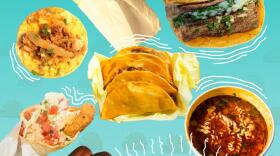High winds that had shaken the valley all night broke just before sunrise Saturday, April 23, the day of the fourth Paiute Culture Walk to be held in Southern Nevada. Previous walks, organized by the Moapa Band of Paiutes, focused on the now-successful effort to have the nearby Reid-Gardner coal-fired power plant shut down and replaced with a tribe-owned solar generating station. Rather than rest on their laurels, former Moapa Band Chairman William Anderson and a small group of his fellow Paiutes started thinking about what they could tackle next.
They settled on protection of Gold Butte, a contested area northeast of Las Vegas that, soon after being proposed for federal protection, was the scene of the standoff between Bunkerville cattle rancher Cliven Bundy and government officials in 2014. Anderson says the rolling orange hills filled with petroglyphs and sandstone formations, along with the adjacent Valley of Fire and Lake Mead, were the stomping grounds of his and other Paiutes’ nomadic ancestors. He and his friends joined with local nonprofits working to shield Gold Butte from development and vandalism, and put together Saturday’s event.
Nine tribes were represented; four of them took flags to be carried by members. One flag-carrier, Fawn Douglas (above, second from right), was the only member of the Las Vegas Paiute Tribe to do the entire 12-mile walk, a moderately difficult, mostly uphill trek on a chewed-up asphalt road. The contemporary artist talked to Desert Companion about her experience.
I UNDERSTAND IT WAS JUST YOU AND YOUR MOTHER FROM THE LAS VEGAS PAIUTE TRIBE?
Yeah, at first. My mother couldn’t walk because she has a bad leg. But then, for the feast at the end, we had more members who came. We had a really good turnout, actually, five on the food team to feed participants; and our cultural committee leader, Kenny Anderson, brought four tribal members and the elders group, because we didn’t want them walking.
SO, JUST YOU WALKING?
Yes.
THAT MEANS YOU HAD TO CARRY YOUR TRIBE’S FLAG FROM BEGINNING TO END?
My daughter came with the food team, and she showed up when I had two miles left. So she carried the flag the last two miles.
I BELIEVE THERE WERE 60 PEOPLE WALKING. WHERE WERE YOU?
(laughs) At the end. There may have been four other people behind me, but I was the last flag carrier. I stopped at four of the tents and made sure I rested, had some water, a banana, and relaxed for a bit.
THE WALK SEEMED DIFFICULT. HOW DID YOU FARE?
You know what? I don’t know, because I don’t have anything to compare it to. But towards the end, mile 8 or so, I was feeling it in my feet. I was like, “Wow, my feet really hurt.” But the weather was good. There were times when I would just put the flagpole across my shoulders and smile, because it was such a good day.
WHAT WAS GOOD ABOUT IT?
My mom was talking about how, at the start of the walk, everyone from all the different tribes was laughing and sharing stories with each other. It was a really a good vibe from beginning to end.
WHAT MESSAGE DID IT SEND TO THE COMMUNITY?
When we come together, we can accomplish anything. Having the different tribes that were all there, it needs to happen more often, really. Tribal people don’t get together enough on issues, and when we did, it was really powerful. It wasn’t just the flags that you saw. There were other tribal members there from other places: Las Vegas Paiute Tribe, Moapa Band of Paiutes, Shivwits Band, Paiute Indian Tribes of Utah — those were the four flags — and then there were also people from Chemehuevi, Colorado River Indian Tribe, Navajo, even the Maori (of New Zealand), who came to support us.
WHAT WAS THE MOST MEANINGFUL PART FOR YOU?
During the celebration at the end of the walk, some people were singing bird songs with gourds, and the elders were the first to get up and dance. My mother was one of them who got up and danced with them. It felt so positive, I was sitting there watching like, wow this is really good.
WAS ANY POLITICAL STATEMENT BEING MADE, ABOUT THE BUNDYS, FOR INSTANCE?
We talked a little bit about that, but it wasn’t a big part of the day. It was a little side topic. When we were driving, we were talking about what would happen if they (the Bundys) were there. And I was like, “You know what? I think I’d invite them to walk with us, and then they could see and feel why this area means so much to us.”
WHAT DOES IT MEAN TO YOU?
That land is sacred to our people. It’s sung about in our “Salt Song,” in a ceremony. I feel really at one with the place. Plus, I’m an artist, I paint, and it’s like you’re walking through a huge historical gallery. I’m working on a Gold Butte collection now.
(Editor’s note: The author’s husband is on the Friends of Gold Butte board.)








